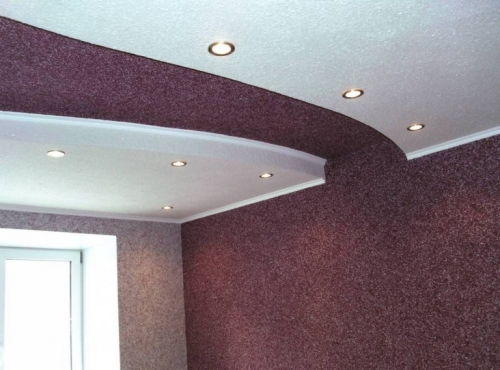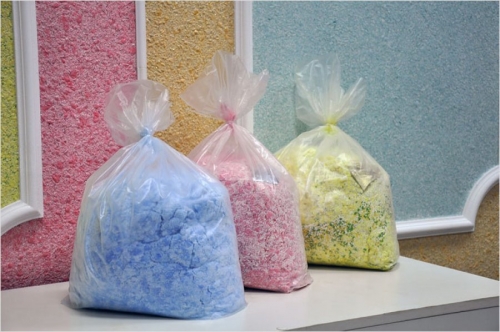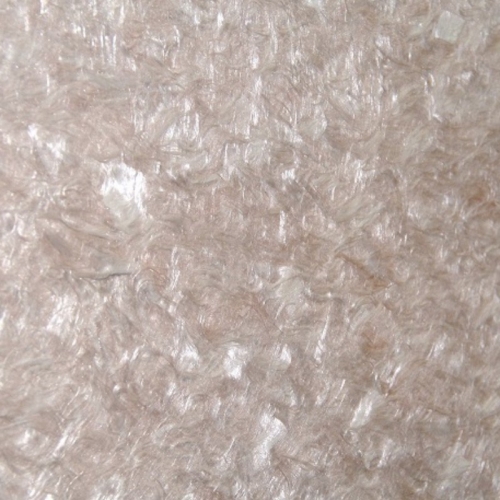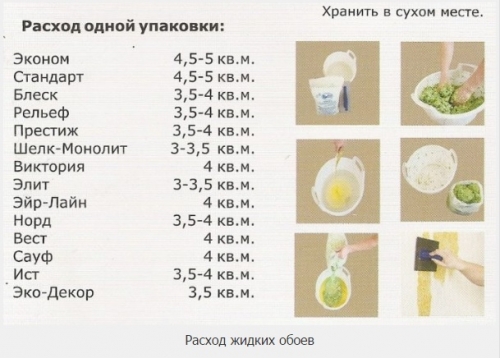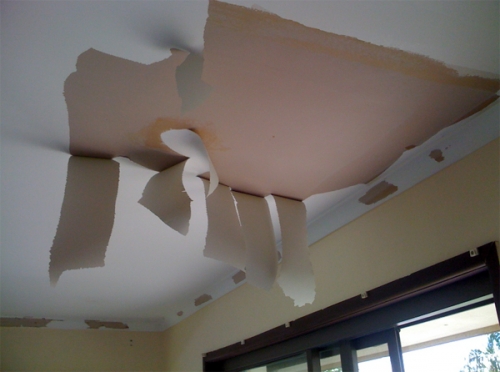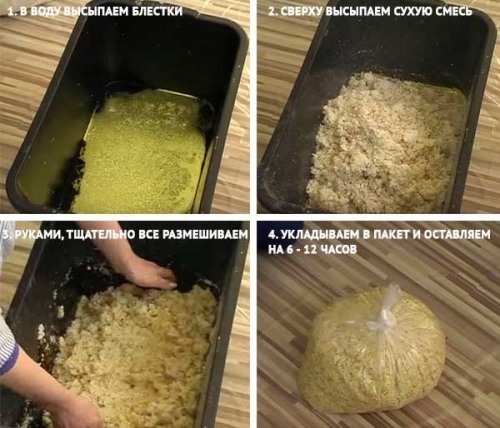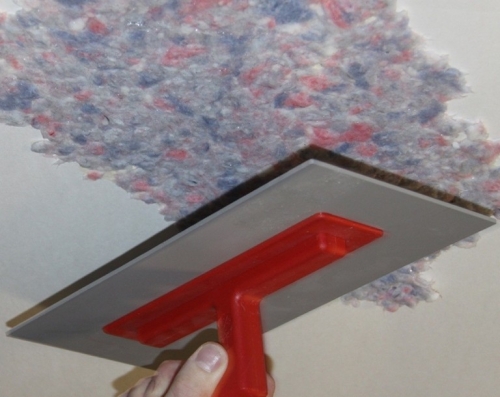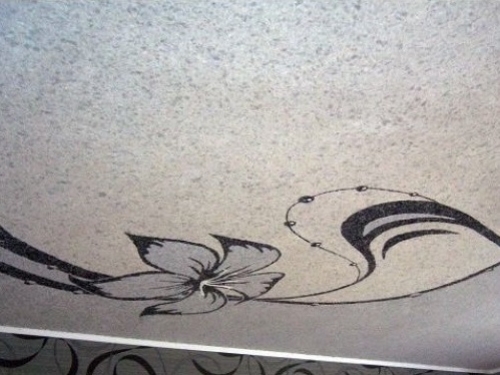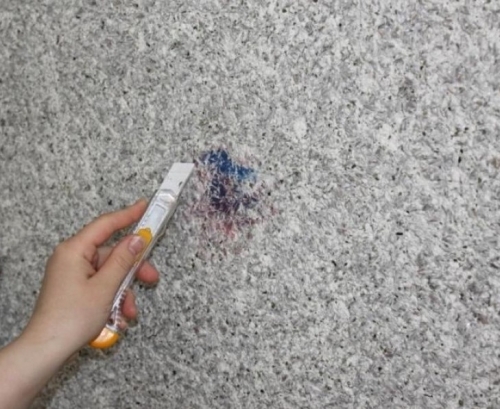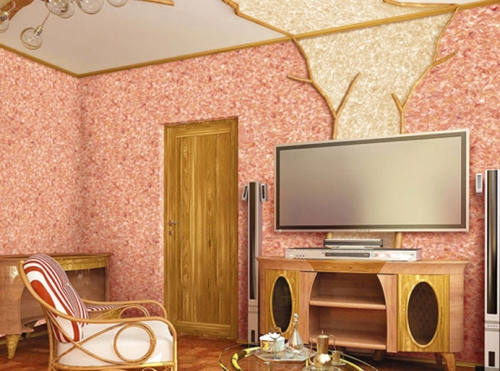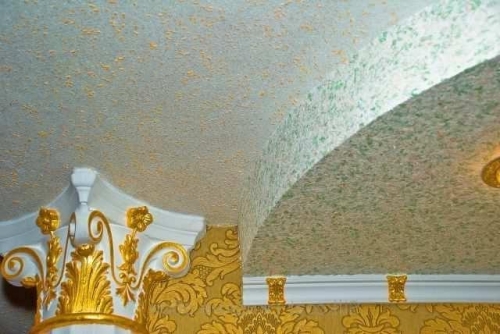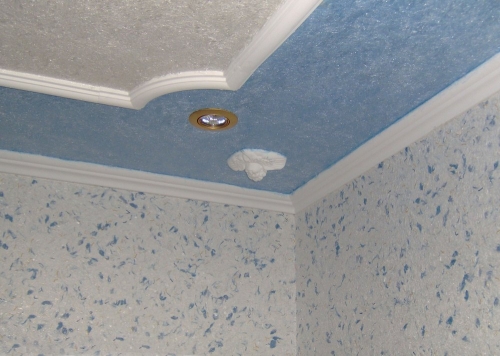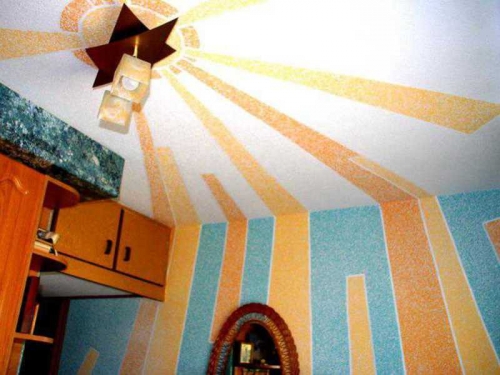A huge number of construction stores are working in large cities that are full of ...
|
|
In the process of building a multi -storey building, one of the main questions is the type ... |
Over the past 10 years, the number of roofing materials has increased significantly, however ... |
. The ceiling is finished with liquid wallpaper. Instructions for applying liquid wallpaper to the ceiling
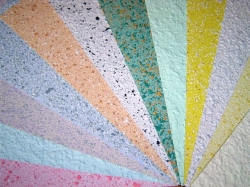
The finishing of the ceiling is performed by various materials. In residential and office premises, liquid wallpapers were increasingly using. The prototype of decorative plaster has many advantages, one of which is the simplicity of application. Observing the simple technology, it will turn out to create a neat coating in a few hours, which harmoniously merges with the interior. More experienced craftsmen create multi -colored ornaments and complex compositions using liquid wallpaper.
- Features of the use of liquid wallpaper
- The choice of a suitable type of wallpaper for the ceiling
- Technology for applying liquid wallpaper: step -by -step briefing
- Combination of tones and creating a drawing
- Surface restoration with liquid wallpaper
- Ceiling design with liquid wallpaper: photo ideas
Features of the use of liquid wallpaper
Liquid wallpaper complex mixture of cellulose and cotton fibers. As a binder, the adhesive composition is used, to give the material the desired color, the dye is added. Liquid wallpaper is universal and practical in use, they are suitable for decoration of the office, living rooms and rooms with high humidity.
The use of liquid wallpaper for the ceiling has a number of advantages:
- simplicity of working with finishing material;
- a wide range of decorative filling the variety of colors and texture of the coating;
- Liquid plaster coating is organically combined with different interior styles;
- the aesthetics of the finish as a result of the work are a seamless surface, which is especially important when arranging multi -level ceilings;
- maintaining a normal microclimate in the room, the use of organic components allows the coating to breathe, preventing the appearance of air and mold;
- the service life of decorative silk plaster about 10 years, the damaged area can be restored;
- in the process of finishing, an elastic coating is formed on the wall, which does not crack and is not deformed when shrinking the house (relevant for new buildings);
- thanks to the fibrous structure of the material, additional heat and sound insulation of the ceiling panels are ensured;
- the decor does not burn out under the influence of sunlight.
The name of the finishing material is due to the method of manufacturing and applying wallpaper. Cellulose shavings are delivered in a dry form, and bring to the desired consistency immediately before use. The styling method is similar to the technology of using decorative plaster, so liquid wallpaper is often called a variety of this coating.
The shortcomings of innovative wallpaper include:
- a relatively high cost compared to the traditional method of decoration;
- despite the moisture resistance declared by the manufacturers, such a coating cannot be equated with detergents.
The choice of a suitable type of wallpaper for the ceiling
Technical characteristics, decorative properties and durability of the decoration largely depend on the type of main component of liquid wallpaper. Four types of compositions are used as a finish ceiling:
- cellulose;
- cotton;
- silk;
- combined.
Pulp wallpaper consist of fibers of cellulose, plasticizers and glue. Some samples are complemented by decorative components. Distinctive qualities of the material:
- high strength of the clutch of the finish with the base;
- susceptibility to UV rays. The wallpaper very quickly fades in the sun, so it is permissible to use them in rooms with artificial lighting: corridor, bathroom, etc.;
- low cost.
The cotton coating for 98% consists of natural fibers, 2% are adhesive binders, mica impurities and additives. Wallpaper is pleasant to the touch.
Silk products are durable, durable wallpapers that do not burn out in the sun. Optimally suitable for decoration of rooms with large windows. The use of decorative additives allows you to cover various textures by imitation of fabric, knitted patterns or marble. Perhaps the only drawback of such wallpaper is their high cost.
Combined compounds are the optimal ratio of the positive characteristics of cellulose and cotton-sgs in one product. The price policy of the assortment varies depending on the percentage of different fibers and decorative impurities.
Technology for applying liquid wallpaper: step -by -step briefing
The technique of working with liquid wallpaper is very simple. However, in order to obtain a high -quality result, it is necessary to adhere to a number of rules when kneading the solution, preparing the base and applying the finish coating.
Calculation and preparation of materials
When buying wallpaper, you should correctly calculate their number. It is advisable to buy the entire batch at once, since in the future dose you can not guess with the tone. The calculation of the required material is preliminarily performed.
On the packaging of wallpaper, the covered area is always indicated with a layer thickness of 1-1.5 mm. As a rule, a package per 1 kg is consumed for 3-6 sq.m. The range of values \u200b\u200bis due to the type and evenness of the base.
Knowing the ceiling area, it is very simple to divide the number of packages of a dry mixture into the recommended area of \u200b\u200bthe manufacturer, the room area is very simple. At the same time, minimal values \u200b\u200bare taken into account.
Important! It is better to buy wallpaper with a small margin. The remainder of the material will be useful in the future during the restoration of the finishing coating
Tools for applying liquid wallpaper:
- plastic or metal containers for kneading a decorative solution;
- kelma or spatula for applying material;
- a rubber roller for the formation of a relief coating uses a structural roller;
- polu found.
To apply plaster with a mechanical method, you need to prepare a spray gun.
Preparation of the ceiling for finishing
Before applying liquid wallpaper to the ceiling, you need to correctly prepare the base. The quality of the first stage is determined by the level of adhesion of the materials. The solution is well grasped with the plates of OSB, clay, wood, cement, brick surfaces and drywall sheets. Preparatory measures are reduced to ensuring the following requirements:
- lack of separating areas on the ceiling;
- moderate moisture absorption.
The procedure for preparing the ceiling for applying liquid wallpaper:
- Remove the remains of the old coating from the surface: wallpaper, plaster, etc.
- Check the evenness of the ceiling and, if necessary, level the base. With minor differences, aligning can be neglected by the defect when applying a decorative layer. Visible gaps are putting.
- Grind the surface. For work, it is advisable to choose the composition of the white color. As an option, you can use white water -based paint.
- Metal elements (corners, anchor, reinforcement, etc.) block oil or latex white enamel.
- To give the base of roughness, soil emulsion with quartz dust is used or sand sand is added to the primer independently.
Kneading the working composition
The intake of the solution requires a clear follow of the instructions. The proportions of dry matter and water can differ for different types of wallpaper, but the sequence of preparation of the mixture remains unchanged:
- In a large-volume plastic container (about 30-40 l), pour warm water with a temperature of about 23-25C. Little fluid is selected from the calculation of the amount of consumed packages. If possible, it is better to immediately make a knead of the total volume.
- Add all available decorative components to the water: sparkles, marble chips, etc. Mix thoroughly so that the elements are evenly distributed.
- Pour all the contents of the bag into the container and mix thoroughly with your hands, fragmenting large lumps.
- The prepared solution must be left for 2-12 hours (the time is indicated on the package), then mix again.
Methods of applying liquid wallpaper
Further technology for working with liquid wallpaper depends on the chosen method of applying decorative plaster manual or mechanically.
Step -by -step work in the manual method of distribution of the composition:
- Install decorative elements on the ceiling: Molding, plinth or stucco molding.
- The ornament depends to decide on the direction of movement of the spatula on this. The fibers of silk and cotton will lie in different ways with circular, longitudinal or transverse movements of the cell. It is better to practice evenly on a flat coating.
- Form a small lump from the solution in the palms, put it on the cell and distribute it evenly by viafit movements along the surface. The thickness of the layer is 1-2 mm.
- In order to prevent the appearance of noticeable joints, the work must be done continuously, avoiding drying the mixture with plots.
- After processing the entire area of \u200b\u200bthe ceiling, roll the coating with a smooth or texture roller.
- To evaluate your own work from the side through the coating should not be visible the original color of the base, tubercles and influxes should be excluded.
In large rooms, it is advisable to use the spray gun. A spray gun with a capacity of 200 l/min with a working pressure of 0.5 MPa is suitable. The mechanical method is not always applicable for applying decorative compositions with fibers of rough texture.
Important! Regardless of the methods of applying liquid wallpaper to the ceiling, it is undesirable to ventilate or artificially heat the room during the surface drying. The term of final hardening is about two to three days.
Surface coating with a protective layer
After drying the liquid wallpaper, it is recommended to open the surface with acrylic varnish. The concentrate does not contain harmful and toxic substances.
The emulsion will increase the resistance of the coating to mechanical damage and pollution. In addition, it will provide the necessary moisture resistance of the material in a humid environment. The formed film allows wet cleaning. The approximate consumption of varnish 1 liter per 15-17 sq.m.
Combination of tones and creating a drawing
The basic basis of the arrangement of a beautiful harmonious interior is the correct combination of color tones of the ceiling, floor and walls. When choosing a palette of shades, some nuances should be taken into account:
- Giving preferences by contrasting combinations, it is advisable to make the walls bright, the floor is dark, and the ceiling is calm light. The dark base adds depth to the space.
- For rooms with high ceilings, it is permissible to use saturated colors. Decorating a small -sized room, it is better to choose a pastel shade for the ceiling. The light top visually stretches the walls.
- In the children's room, bright, colorful ornaments and patterns look harmoniously. A multi -colored ceiling creates an atmosphere of childhood and a holiday.
Having shown imagination and a little perseverance, it will be possible to create an original pattern on the ceiling with liquid wallpaper. Phased work:
- Create a sketch of composition on paper and transfer it to the ceiling. For convenience and accuracy, you can make a cardboard template. The lines are drawn on the ceiling with a simple pencil.
- In different containers, prepare solutions of the desired color.
- Inside the ornament, apply liquid wallpaper and distribute them along the desired color area, going beyond the boundaries of the circuit by 1-2 mm.
- After waiting for complete drying, it is similar to the neighboring areas. A small spatula towards the finished coating should form a clear circuit between fragments of the composition.
To create a multi -color composition, silk wallpaper is optimal.
Surface restoration with liquid wallpaper
If, after all the work, the excess of the prepared solution remained, then the material must be dried and saved for subsequent repair. Lay the wet mixture into polyethylene and flatten the layer thickness of about 2 cm. After drying, collect dry chips in a bag and tie it tightly. Repeated kneads are performed according to the instructions described above.
To carry out local repair, you need to prepare:
- spray for colors;
- plastic grater;
- putty knife.
Restoration sequence:
- Moisten the damaged surface with abundantly warm water from the sprayer.
- Wait for the material to bring water and soften.
- Remove the plastic composition from the ceiling with a spatula.
- Cover the area with a fresh working solution, comparing the surfaces.
After complete drying, the restored element will take the color of the entire ceiling.
Ceiling design with liquid wallpaper: photo ideas
The combination of flooring techniques and ceiling changes the spatial perception of the room, making the room visually wider.
Game of contrasts: a harmonious combination of golden color and green malachite.
The combination of white and blue is a win -win option for the interior of the living room, bedrooms or halls.
Decorating the ceiling with sunlight adds a room of light and brightness. The chandelier, selected in tone, is associated with the sun.
Liquid wallpaper on the ceiling: video

